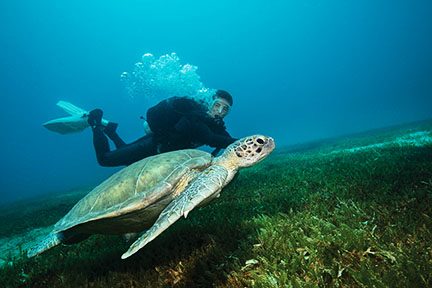DAN® medical information specialists and researchers answer your dive medicine questions.

Q: During dive training in the pool, I couldn’t breathe after clearing my mask with my regulator in my mouth. After surfacing, I took six to eight wheezing breaths and then could breathe normally again. It’s possible I inhaled water during the exercise, but my instructor and I could not recall when or how that would have happened. Someone at the training center suggested that something might be wrong with my epiglottis. Is there a way to inspect the epiglottis to ensure it is functioning properly? What causes it to relax and open back up?
A: It is not uncommon for new divers to have some anxiety when fully removing their mask underwater. When you expose your nose to the water, it’s natural to feel uncomfortable if water enters the nasopharynx. Our bodies are trained not to take a breath while underwater, but it is possible if you can relax and focus on breathing through your regulator.
If water entered the larynx, the epiglottis’ natural response would be to close the airways to prevent aspiration. The larynx would reflexively trigger coughing to expel the fluid, or you would try to remove the fluid through exhalation. Even a small amount of fluid can induce laryngospasm, which will stimulate this powerful reflex.
This passage from Marieb and Hoehn’s Anatomi dan Fisiologi Manusia is a good overview of how the epiglottis works: “When only air is flowing into the larynx, the inlet to the larynx is wide open and the free edge of the epiglottis projects upward. During swallowing, the larynx is pulled superiorly and the epiglottis tips to cover the laryngeal inlet. Because this action keeps food out of the lower respiratory passages, the epiglottis has been called the guardian of the airways. Anything other than air entering the larynx initiates the cough reflex to expel
the substance.”
Another possibility is that you had an anxiety-induced laryngospasm, which can be triggered by discomfort, panic, or high anxiety. Some physicians think this spasm is part of the body’s natural defense against accidental drowning or suffocation and may be part of the body’s response to fluid in the larynx.
Your breathing problem may be an issue with your comfort level and experience, but it’s possible there are other complications we cannot identify based on the information you provided. Discuss these concerns with your physician, and request a fitness-to-dive evaluation to ensure that you have no physical contraindications to dive activity. Your physician may refer you to an ENT for further investigation, if needed.
Jika dokter Anda mengizinkan Anda untuk menyelam, kami sarankan agar Anda menyelesaikan waktu tambahan di kolam renang yang ketat untuk melatih keterampilan dengan instruktur Anda sebelum melanjutkan pelatihan Anda lebih jauh.
- Ben Strelnick, NREMT, W-EMT

Q: Dapatkah seseorang yang didiagnosis dengan hipertensi pulmonal menjadi penyelam?
A: Hipertensi pulmonal dianggap sebagai kondisi risiko berat, dan menyelam tidak disarankan bagi siapa pun dengan diagnosis ini. Olahraga ketahanan seperti menyelam, yang cenderung menimbulkan tuntutan hemodinamik tertinggi dan memerlukan tingkat kebugaran fisik yang tinggi, merupakan tantangan bagi penderita hipertensi paru. Tekanan yang ditimbulkan oleh menyelam pada paru-paru dan sisi kanan jantung mungkin terlalu berat bagi orang tersebut. Kekhawatiran akan gagal jantung kongestif atau edema paru yang diakibatkan oleh perendaman hanyalah dua faktor risiko yang signifikan.
A person’s preexisting condition and exercise intolerance will affect the heart and lungs’ ability to perform underwater. Various factors while underwater lead to intravascular volume shifts to the central circulation involving the heart, coronary vessels, and lungs. In a healthy state, this increase in fluid usually causes no problem, but a person with pulmonary hypertension will struggle, sometimes even at rest, to keep up with the right ventricle’s increased workload as it tries to overcome the elevated pressure within the pulmonary vessels.
— Shannon Sunset, NCPT, NREMT
Q: Saya mengalami gegar otak beberapa minggu yang lalu. Kapan saya bisa kembali menyelam?
A: Given that your injury occurred a few weeks ago, it is still too early in your recovery to give specific return-to-dive recommendations. Diving may be possible for you, but whether it’s safe is not a quick and easy answer because there are many additional factors to consider regarding a concussion. If you experienced a loss of consciousness (LOC) that caused you to fall or that otherwise led to your concussion, however, you should seek further evaluation to determine the cause of that LOC and if that condition is compatible with diving.
Risiko kejang adalah salah satu masalah terbesar dalam menentukan kebugaran untuk menyelam setelah cedera kepala. Waktu tunggu yang disarankan sebelum kembali menyelam bervariasi, tergantung pada tingkat cedera, masa pemulihan, dan risiko kejang. Kembali menyelam didasarkan pada pemulihan tanpa gejala dan evaluasi oleh tim dokter Anda.
Rekomendasi terbaik adalah fokus pada pemulihan Anda dan tidak melanjutkan menyelam selama periode ini. Menentukan risiko kejang setelah cedera kepala diperlukan sebelum mempertimbangkan untuk kembali menyelam. Setelah Anda benar-benar sembuh dan dibebaskan oleh tim dokter Anda untuk beraktivitas secara penuh dan tidak terbatas, mintalah evaluasi kebugaran untuk menyelam dari dokter yang memiliki pengetahuan tentang pengobatan selam sebelum mencoba menyelam.
— Anne Strysniewicz, AEMT, DMT

Q: Saya menderita sindrom Marfan dan menginginkan informasi dari seseorang yang berspesialisasi dalam menyelam dan risiko-risiko terkait. Ahli jantung saya telah merekomendasikan untuk tidak menyelam, tetapi orang dengan sindrom Marfan biasanya memiliki aktivitas fisik yang terbatas, jadi saya tidak terkejut. Saya telah dirawat seumur hidup saya dan mempertahankan gaya hidup yang sangat aktif, termasuk berenang, polo air, bola basket, dan lari maraton, yang bertentangan dengan semua rekomendasi. Apa saja risiko bagi penderita Marfan yang menyelam, dan adakah yang dapat saya lakukan untuk menguranginya?
Marfan syndrome has an extensive spectrum of presentation from mild to severe and requires your physician team’s assessment. Many factors may have influenced your cardiologist’s recommendation against diving despite the active physical activities that you describe.
Dokter akan dengan hati-hati memisahkan daftar aktivitas yang sesuai. Menyelam memengaruhi berbagai sistem tubuh, sehingga tekanan ekstra pada sistem yang dipengaruhi oleh sindrom Marfan merupakan pertimbangan penting. Berikut ini adalah beberapa kondisi khusus yang perlu dipertimbangkan:
- Pelebaran dan pembedahan aorta: Perubahan cairan yang terjadi saat menyelam dapat membuat aorta tertekan.
- Kondisi katup jantung, kardiomiopati, dan disritmia: Masalah potensial ini sering kali lebih signifikan jika terjadi di bawah air.
- Pneumotoraks: Marfan syndrome can have a higher association with pneumothorax. There can be a risk of spontaneous pneumothorax (collapsed lung) with little or no inciting event. Although problematic on land, it is life-threatening while diving. Pulmonary barotrauma can cause a collapse of anyone’s lung. Upon ascent, trapped air expands and may cause a collapsed lung to develop into a tension pneumothorax, a medical emergency in which air cannot escape the pleural space around the affected lung, increasing
risiko sindrom inflasi berlebih pada paru, seperti emboli gas arteri. - Skoliosis: Kelengkungan tulang belakang telah dikaitkan dengan sindrom Marfan. Tergantung pada tingkat keparahannya, skoliosis dapat menyebabkan berkurangnya toleransi olahraga, sehingga membuat aktivitas menyelam rutin seperti membawa perlengkapan, menaiki tangga perahu, atau berenang melawan arus menjadi lebih sulit.
- Dura tulang belakang: There may be changes to the spine’s dura that can result in pain and headache. These changes may have a confounding impact on the diagnosis of spinal decompression illness (DCI).
- Pengaturan termal: Mengenakan pelindung termal dapat menunda penurunan suhu inti dari pencelupan dalam air, tetapi pada akhirnya Anda akan menjadi dingin, dan pengaturan sendiri mungkin sulit dilakukan. Anda harus meninjau pengaturan suhu dengan dokter Anda.
Medications and your baseline wellness are also worth reviewing. Some medications may have adverse reactions that may be a contraindication to diving. Your daily wellness is a necessary consideration, as are any regularly occurring pain or deficits that may make diagnosing DCI difficult. It’s essential to have an open discussion with your treating physician and follow their recommendations.
— Robert Soncini, NR-P, DMT